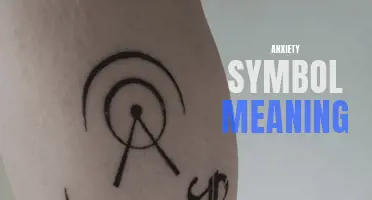
Have you ever glanced at the dashboard of your car and wondered what the battery symbol means? We rely on our cars to get us from point A to point B, but it's easy to take for granted the complex system of components that keep our vehicles running smoothly. One such component is the battery, and the battery symbol on your dashboard is there to alert you to any potential issues that may arise. In this article, we'll explore the meaning behind this symbol and what you should do if you see it illuminated. So buckle up and let's dive into the world of automotive batteries!
What You'll Learn
- What does the battery symbol on the dashboard mean in a car?
- How can I tell if my car's battery is low based on the dashboard symbol?
- If the battery symbol on the dashboard is on, does that mean the car won't start?
- Are there any other possible causes for the battery symbol to appear on the dashboard besides a low battery?
- What should I do if the battery symbol on the dashboard is on?

What does the battery symbol on the dashboard mean in a car?
The battery symbol on the dashboard of a car is an important indicator that can alert drivers to potential issues with the vehicle's electrical system. This symbol typically looks like a rectangle with a plus sign on one side and a minus sign on the other, indicating the positive and negative terminals of a battery.
When this symbol lights up or flashes on the dashboard, it is often a sign that there is a problem with the car's charging system or battery. Here are a few possible reasons why the battery symbol may be illuminated:
- Low Battery Voltage: If the battery symbol lights up when you start your car but then turns off after a few seconds, it could be a normal part of the car's startup process. However, if the symbol stays illuminated or reappears while driving, it may indicate that the battery is not receiving a sufficient charge from the alternator.
- Faulty Alternator: The alternator is responsible for recharging the battery while the engine is running. If the alternator is not functioning correctly, it may not be able to provide enough power to keep the battery charged. This can cause the battery symbol to illuminate on the dashboard. In addition to the battery symbol, you may also notice other signs of a faulty alternator, such as dimming headlights or a loss of electrical power.
- Battery Issues: The battery itself may be the culprit behind the illuminated battery symbol. If the battery is old or defective, it may not hold a charge efficiently, leading to a loss of power and the symbol appearing on the dashboard. In some cases, a drained or dead battery can be jump-started to get the car running temporarily, but it is essential to have the battery replaced as soon as possible.
- Loose or Damaged Connections: Electrical connections, such as the battery cables, can become loose or damaged over time. If there is a poor connection between the battery and the rest of the electrical system, it can cause the battery symbol to turn on. Inspecting the battery terminals and cables for any signs of corrosion, fraying, or looseness is crucial.
When the battery symbol illuminates on the dashboard, it is important not to ignore it. Ignoring the issue can lead to a complete loss of power while driving, leaving you stranded on the road. It is advisable to have the vehicle inspected by a qualified mechanic who can diagnose the problem and perform any necessary repairs.
Regular maintenance, such as checking the battery's condition and ensuring the alternator is functioning correctly, can help prevent unexpected battery-related issues. If you notice the battery symbol on your car's dashboard, it is best to address the problem promptly to avoid any further complications and maintain a reliable electrical system.
The Mystical Significance of the Zoso Symbol: Decoding Its Meaning
You may want to see also

How can I tell if my car's battery is low based on the dashboard symbol?
If you notice a dashboard symbol that looks like a battery, it indicates that your car's battery may be low. This symbol is often a red battery icon, and it's important to address the issue as soon as possible to avoid being stranded with a dead battery.
There are several signs that can help you identify if your car's battery is low based on the dashboard symbol:
- Dim Lights: If you notice that your headlights, interior lights, or dashboard lights are dimmer than usual, it could be a sign of a low battery. The battery provides power to these components, and when it's running low, the lights may not be as bright as they should be.
- Slow Engine Crank: When you try to start your car, you may notice that the engine cranks slower than usual. This could be due to a weak battery that is struggling to provide enough power to start the engine. If you hear a clicking sound when you turn the key, it is often an indication of a low battery.
- Difficulty Starting the Car: A low battery can make it harder for your car to start, especially in cold weather. If you have to turn the key multiple times or hold it for an extended period before the engine starts, it could be a sign of a low battery.
- Electrical Issues: If you experience any electrical problems, such as the power windows or radio not working properly, it could be due to a low battery. The battery provides power to all the electrical components in your car, so a weak battery can lead to various electrical issues.
- Warning Lights: In addition to the battery symbol, other warning lights on your dashboard may illuminate if your battery is low. These can include the check engine light, ABS light, or other warning lights specific to your car model. If you see multiple warning lights along with the battery symbol, it's important to have your battery checked as soon as possible.
If you notice any of these signs or the battery symbol on your dashboard, it's essential to have your battery tested and replaced if necessary. A low battery can leave you stranded and may also indicate a larger electrical issue with your car. You can take your car to a trusted mechanic or a battery specialist to have the battery tested and replaced if needed.
To prevent a low battery, it's a good idea to have your battery checked regularly, especially if it is more than three years old. Extreme temperatures and frequent short trips can also drain the battery faster. If you are not using your car for an extended period, consider disconnecting the battery or using a trickle charger to maintain its charge.
Remember, a properly functioning battery is crucial for your car's electrical system. If you notice any signs of a low battery, it's important to address the issue promptly to avoid any inconvenience or potential damage to your vehicle.
The Meaning Behind Recovery Symbols: Unveiling the Significance of Strength and Resilience
You may want to see also

If the battery symbol on the dashboard is on, does that mean the car won't start?
If the battery symbol on the dashboard is illuminated, it does not necessarily mean that the car won't start. The battery symbol is an indicator that there may be an issue with the vehicle's charging system, including the battery, alternator, or other related components.
When the battery symbol is on, it typically indicates that the battery is not being charged properly. This can be caused by a variety of factors, such as a faulty alternator, a loose or corroded battery connection, a broken drive belt, or a weak battery. In some cases, it may be as simple as a loose or damaged battery terminal.
While having the battery symbol on does not guarantee that the car won't start, it is certainly a warning sign that the battery may be draining or not functioning optimally. If the battery is not being charged while the car is running, it may eventually become too weak to start the engine.
If you notice the battery symbol on the dashboard, it is recommended to address the issue as soon as possible to avoid potential problems. Here are a few steps you can take to troubleshoot the issue:
- Check the battery connections: Make sure the battery terminals are clean and tight. Loose or corroded connections can prevent the battery from charging properly.
- Inspect the drive belt: A broken or loose drive belt can cause the alternator to malfunction, leading to battery charging issues. Look for any signs of wear or damage and replace if necessary.
- Test the battery voltage: Use a multimeter to check the battery voltage. A healthy battery should have a voltage of around 12.6 volts. If the voltage is significantly lower, it may indicate a weak or dead battery that needs to be replaced.
- Check the alternator: If the battery connections and voltage are in good condition, the issue may lie with the alternator. An alternator test can determine if it is functioning properly or if it needs to be repaired or replaced.
If you are unsure of how to perform these checks or if you are unable to resolve the issue on your own, it is best to consult a professional mechanic. They will have the knowledge and tools to diagnose and repair the problem correctly.
In conclusion, while the battery symbol on the dashboard is a warning sign of potential battery or charging system issues, it does not necessarily mean that the car won't start. However, it is important to address the issue promptly to avoid any further complications and ensure the reliable operation of your vehicle.

Are there any other possible causes for the battery symbol to appear on the dashboard besides a low battery?
If you see a battery symbol on your car's dashboard, it could indicate a low battery, but it could also be a sign of other possible causes. Here are some things to consider when you encounter this symbol:
- Low battery voltage: The most common reason for the battery symbol to appear on the dashboard is a low battery voltage. This could be due to a weak or failing battery, a faulty alternator that is not charging the battery properly, or a loose or corroded battery cable.
- Faulty battery sensor: Some vehicles have a battery monitoring system that can detect the battery's state of charge and report it to the dashboard. If this sensor is faulty or malfunctioning, it may incorrectly indicate a low battery even if the actual battery voltage is fine.
- Electrical system issues: The battery symbol may also appear if there are issues with the electrical system in the car. This could include a faulty voltage regulator, a short circuit, or a problem with the car's wiring. These issues can affect the charging and discharging of the battery, leading to a low battery symbol.
- Weakened battery terminals: If the battery terminals are loose or corroded, it can disrupt the electrical connection between the battery and the rest of the car's electrical system. This can result in a low battery symbol on the dashboard.
- Software or computer issues: In some cases, a malfunctioning software or computer system in the car may inaccurately display the battery symbol. This can be due to a glitch or a problem with the car's onboard computer.
To determine the exact cause of the battery symbol appearing on the dashboard, it is recommended to have the car diagnosed by a professional mechanic. They will be able to use diagnostic tools and perform various tests to accurately pinpoint the issue. Ignoring the battery symbol or assuming it is only due to a low battery can lead to further damage to the electrical system or result in a breakdown. It is always better to address the issue promptly and ensure the car's electrical system is functioning properly.
Decoding the Meaning Behind the Powerful Wu-Tang Clan Symbol
You may want to see also

What should I do if the battery symbol on the dashboard is on?
If you've noticed the battery symbol on your car's dashboard lighting up, it can indicate a potential issue with your vehicle's charging system. Ignoring this warning sign can lead to a dead battery and leave you stranded on the side of the road. In this article, we'll discuss what you should do if the battery symbol on the dashboard is on.
- Don't panic: While seeing a warning light on your dashboard can be concerning, it's important to stay calm and assess the situation. Panicking will only cloud your judgment, so take a deep breath and focus on finding a solution.
- Check the connections: Start by inspecting the battery connections to ensure they are clean and tight. Loose or corroded terminals can disrupt the flow of electricity and trigger the battery warning light. If you notice any issues, tighten the connections or clean off any corrosion using a battery cleaning brush.
- Check the belt: The battery symbol can also illuminate if the serpentine belt that drives the alternator is loose or broken. Open the hood and visually inspect the belt for any signs of damage or excessive wear. If the belt appears to be in bad condition, have it replaced by a professional.
- Test the battery voltage: Use a voltmeter to measure the voltage across the battery terminals. A fully charged battery should read around 12.6 volts. If the voltage is significantly lower, it could indicate a problem with the battery or charging system. In this case, it is recommended to have your battery and charging system tested by a qualified mechanic.
- Avoid high electrical loads: Until you have resolved the issue, try to minimize the use of electrical accessories such as headlights, air conditioning, and radio. These devices put additional strain on the battery and may deplete its charge faster.
- Seek professional help: If you're unable to identify or fix the problem yourself, it's best to seek the assistance of a professional mechanic. They have the knowledge and equipment necessary to diagnose and repair faults in the charging system.
In conclusion, if the battery symbol on your car's dashboard is on, it's essential to address the issue promptly to avoid potential breakdowns. Start by checking the battery connections and the condition of the serpentine belt. If the problem persists, have the battery and charging system tested by a professional. Remember, regular maintenance and inspections can help prevent unexpected issues with your vehicle's electrical system.
Unveiling the Profound November Meaning and Symbolism
You may want to see also
Frequently asked questions
The battery symbol on the dashboard is an indicator that there may be a problem with your vehicle's battery or charging system. It typically appears as a picture of a battery with a positive and negative sign on the top or side. When this symbol lights up, it is a warning that your battery is not being charged properly or that there is a malfunction in the charging system.
If the battery symbol on the dashboard lights up, it is important to address the issue as soon as possible. This could mean that your battery is weak or dying, or that there is a problem with the alternator or other components of the charging system. You should have your battery and charging system checked by a professional mechanic to determine the exact cause of the issue and to prevent any further problems or breakdowns.
It is generally not recommended to continue driving your car if the battery symbol on the dashboard is on. This indicates that your battery is not being charged properly, and driving with a weak or dying battery can cause further damage to the vehicle's electrical system. If the battery completely dies while driving, you may experience a loss of power and be unable to start the engine again. It is best to have your vehicle inspected and repaired by a qualified mechanic before continuing to drive.







